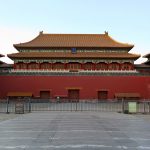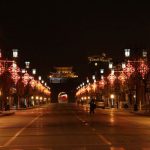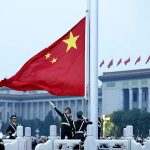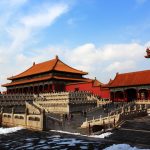
Fragrant Park , also known as the Forest Park, is located on the eastern sides of the Western Hills, approximately 10 kilometers to the west of Beijing.
Due to its high elevation and dense cover of trees, spring arrives late in the area and summer days are always pleasantly cool. The best time to visit the park is late fall, when the smoke tree leaves turn red. The trees make the grandest display of all. There are also groves of apricots, pears, peaches and lilacs adding their fragrance, and the more solemn evergreens, whose contribution to the local beauty is unrestricted by seasonal changes.
 A poem of Marshal Chen Yi reads:
A poem of Marshal Chen Yi reads:
The red leaves of the Western Hills
Because even redder as the frost thickens.
And an earlier poem by the Tang Dynasty poet Du Mu treats the same subject:
Stopping in my sedan chair in the evening, I sit admiring the maple grove;
The frost-covered leaves are redder than the flowers of spring.
In 1186 of the Jin Dynasty, the Xiangshan Temple was built here and for a period served as the emperor’s traveling lodge. In 1745, Emperor Qianlong had a number of large halls; pagodas, memorial archways and leisure pavilions built and changed the name of the area to the Garden of Peacefulness (Jingyiyuan). This complex served the famous Qing ruler as one of his summer palaces and became one of the three favorite hills of Qianlong, beside Jade Spring Mountain (Yuquanshan) and Longevity Hill (Wanshoushan) in the Summer Palace.
 Qianlong’ s elaboration of the park consisted of 28 separate vistas, each with a poetic name: Jade China Cliff, Toad Peak, Jade Milk Spring, Bell Separated from the Clouds, etc. Unfortunately, almost every trace of this carefully orchestrated symphony of landscape architecture, including the blueprints, was burned or destroyed by the Anglo-French forces and the eight-Power Allied Forces in the 19th and early 20th centuries. The more important extant sites are as follows:
Qianlong’ s elaboration of the park consisted of 28 separate vistas, each with a poetic name: Jade China Cliff, Toad Peak, Jade Milk Spring, Bell Separated from the Clouds, etc. Unfortunately, almost every trace of this carefully orchestrated symphony of landscape architecture, including the blueprints, was burned or destroyed by the Anglo-French forces and the eight-Power Allied Forces in the 19th and early 20th centuries. The more important extant sites are as follows:
Jianxin Study: Built first in the Jiajing period of the Ming Dynasty, this complex of buildings stands to the west of Eyeglasses Lake. The study contains a semi-circular pond and an adjacent pavilion, surrounded on three sides by covered galleries. Beyond the pavilion are rockery hill and a grove of trees concealing a gazebo.
Zhaomiao (Luminous) Temple: Constructed in 1780 in the Qianlong period, this Lamaist temple is said to have been built especially for the Panchen Lama. In its center, a Red Terrace rises 10 meters above the ground. On its eastern side is a memorial the archway of white marble and glazed tile, while on the slope to the west is a seven-story glazed pagoda, the eaves of which are hung with tiny bells, which tinkle with even the slightest breeze.
The Tree-Covered Imperial Audience Tablet: Located to the southwest of the Chaoyang Caves, this group of steep cliffs with numerous trees resembles a giant hu – the rectangular tablet officials held before themselves in the presence of the emperor.
 Guijianchou (Worried Ghost) Peak: The main peak of Xiangshan Park, Worried Ghost Peak had an elevation of 557 meters. Clouds and mist often engulf its precipitously angled cliffs, which give the two large stone excrescences of the peak a resemblance to incense burners. It is from this that the name Xiangshan or Incense Mountains (and not Fragrant Hills, as the area had been mistakenly called for generations) is derived.
Guijianchou (Worried Ghost) Peak: The main peak of Xiangshan Park, Worried Ghost Peak had an elevation of 557 meters. Clouds and mist often engulf its precipitously angled cliffs, which give the two large stone excrescences of the peak a resemblance to incense burners. It is from this that the name Xiangshan or Incense Mountains (and not Fragrant Hills, as the area had been mistakenly called for generations) is derived.
From the peak, the winding Yongding River like a white silk belt fluttering among the western valleys, the Marco Polo Bridge on the river, Shijing Mountain, the Summer Palace and Jade Spring Mountain can all be seen from here, and on a clear day one can even make out the skyline of Beijing.










